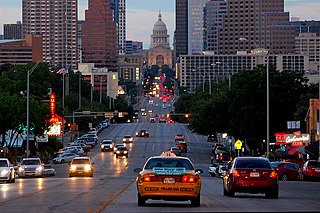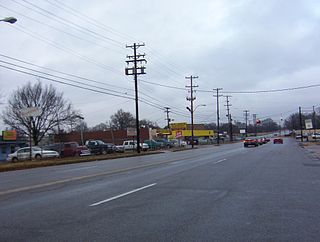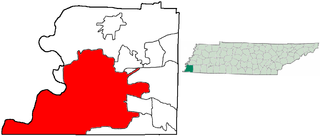A streetcar suburb is a residential community whose growth and development was strongly shaped by the use of streetcar lines as a primary means of transportation. Such suburbs developed in the United States in the years before the automobile, when the introduction of the electric trolley or streetcar allowed the nation’s burgeoning middle class to move beyond the central city’s borders. Early suburbs were served by horsecars, but by the late 19th century cable cars and electric streetcars, or trams, were used, allowing residences to be built farther away from the urban core of a city. Streetcar suburbs, usually called additions or extensions at the time, were the forerunner of today's suburbs in the United States and Canada. San Francisco's Western Addition is one of the best examples of streetcar suburbs before westward and southward expansion occurred.
Midtown is a collection of neighborhoods in Memphis, Tennessee, to the east of Downtown.

Downtown Memphis, Tennessee is the central business district of Memphis, Tennessee and is located along the Mississippi River between Interstate 40 to the north, Interstate 55 to the south and I-240 to the east, where it abuts Midtown Memphis.

Central Gardens is a historic Memphis neighborhood in Midtown.

Congress Avenue is a major thoroughfare in Austin, Texas. The street is a six-lane, tree lined avenue that cuts through the middle of the city from far south Austin and goes over Lady Bird Lake leading to the Texas State Capitol in the heart of Downtown.

Nutbush is a rural unincorporated community in Haywood County, Tennessee, United States, in the western part of the state, approximately 50 miles northeast of Memphis. It was established in the early 19th century by European-American settlers who bought enslaved African Americans to develop the area's cotton plantations. The houses and churches that were built during this time still stand.
South Memphis, one of the oldest portions of Memphis, Tennessee, is a community stretching from Midtown and Downtown to the Mississippi state line. In its early days, it was primarily an agrarian community. South Memphis has many well-known neighborhoods including Whitehaven, Lauderdale Sub, Longview, Riverside, Lakeview Gardens, Prospect Park, Dukestown, Gaslight Square, Wilbert Heights, Mallory Heights, Dixie Heights, Barton Heights, Elliston Heights, Handy Holiday, Chickasaw Village, Pine Hill, Indian Hills, Bunker Hill, Westwood, Boxtown, West Junction, Walker Homes, Coro Lake, Nehemiah, and French Fort. Many of these neighborhoods are considered home to many famous hip hop/R&B singers and rappers. Many locations in South Memphis are also considered a hotbed for crime and violence due to the high amount of gang influence and the overall poverty level of the area. But South Memphis is known for its plentiful houses of worship including Mt. Vernon Baptist Church Westwood, St. Andrew AME Church, Washington Chapel CME Church, East Trigg Baptist Church, White's Chapel AME Church, Union Valley Baptist Church, Enon Springs Baptist Church, Warner Temple AME Zion Church, Unity Baptist Church, Ford's Chapel AME Zion Church, St. Augustine Catholic Church, and Monumental Baptist Church, just naming a few.

Venice Boulevard is a major east–west thoroughfare in Los Angeles, running from the ocean in the Venice district, past the I-10 intersection, into downtown Los Angeles. It was originally known as West 16th Street under the Los Angeles numbered street system.
East Memphis is a region of Memphis, Tennessee with several defined and informal subdivisions and neighborhoods such as Colonial Acres, White Station-Yates, Sherwood Forest, Normal Station, High Point Terrace, Belle Meade, Normandy Meadows, St. Nick, Pleasant Acres, Balmoral, and Ridgeway. The general boundaries are informal:

North Memphis is one of the five defined districts of Memphis, Tennessee. It includes smaller neighborhoods such as Klondike, New Chicago, Douglass, Hyde Park, Hollywood, Nutbush, Binghampton, Smokey City, Scutterfeld, Frayser, and Raleigh.
Columbus, the state capital and Ohio's largest city, has numerous neighborhoods within its city limits. Neighborhood names and boundaries are not officially defined. They may vary or change from time to time due to demographic and economic variables.

Nutbush is a long-standing neighborhood in northeastern Memphis, Tennessee, United States.

State Route 14 is a south–north route from the Mississippi border in Memphis, Tennessee to an intersection with State Route 54 in Tipton County.
Normal Station is a neighborhood in East Memphis, Tennessee, anchored by the University of Memphis, formerly Memphis State University, and originally called West Tennessee State Normal School. It is bordered by the University of Memphis to the north, Audubon Park to the east, Park Avenue and the Sherwood Forest neighborhood to the south, and Highland Street to the west.

The City of Memphis is located on the eastern bank of the Mississippi River in the southwest corner of the U.S. state of Tennessee. It is the regional hub for a tri-state area of Arkansas, Mississippi and Tennessee.

The Grandin Road Commercial Historic District, also referred to as Grandin Village, is a historic district listed on the National Register of Historic Places located in the Raleigh Court neighborhood of the independent city of Roanoke, Virginia. Centered at the intersection of Memorial Avenue and Grandin Road, Grandin Village hosts an array of independently owned retail and dining establishments. The district has been noted as one of Roanoke's best examples of a mixed-use urban village, and has been used as a local model for future mixed-use developments within the community.

Sam Cooper Boulevard is an urban highway in Memphis, Tennessee, United States. The more recent western segment of the road follows a parkway design, while the older eastern portion, which was proposed and constructed as a segment of Interstate 40 (I-40), is built as a freeway, without at-grade intersections and traffic lights. The western terminus of Sam Cooper Boulevard is at East Parkway North. At the western termination point of the road there is a short concurrency of East Parkway North with U.S. Route 64 (US 64), US 70, and US 79. From its western end, Sam Cooper Boulevard continues east for 5.8 miles (9.3 km) to reach its eastern terminus at the I-40/I-240 interchange.

Binghampton is a neighborhood on an edge of Midtown in Memphis, Tennessee. It is named after W. H. Bingham, an Irish immigrant, hotelier, planter, magistrate, politician, and entrepreneur who founded a town to the east and slightly north of the Memphis city limits in 1893.
The Memphis Street Railway Company was a privately owned operator of streetcars (trams) and trolleybuses in Memphis, Tennessee on roughly 160 route miles of overhead electrified cable and rails between 1895 and 1960. The longest of the rail lines reached from downtown to Memphis National Cemetery near Raleigh.


















